| Article ID | Journal | Published Year | Pages | File Type |
|---|---|---|---|---|
| 9796380 | Materials Science and Engineering: A | 2005 | 9 Pages |
Abstract
Thixoforming is a forming process that shapes metal components in their semi-solid state. Prior to forming, the microstructure of the alloy consists preferably of solid metal spheroids in a liquid matrix, which can be difficult to achieve with hot-worked, high alloy steels prone to strong microsegregation bands. A high performance HP9/4/30 steel has been assessed for thixoformability through a direct remelting route. Partial remelting was carried out between 1430 and 1470 °C. Liquation occurred initially at grain boundaries, then also along the segregation bands. With increasing time and hold temperature, these “columns” broke down into shorter, more equiaxed segments, offering more chance of being thixoformed. Successful thixoforming producing net-shape demonstrator parts was achieved at processing temperatures in the range of 1470-1480 °C, which corresponds to approximately 50-80% liquid (based on differential thermal analysis). A thin solid skin, formed on the surface of the slug as a result of heat loss, had prevented the slug from collapsing. The resulting thixoformed products are discussed in relation to their load-displacement signals.
Related Topics
Physical Sciences and Engineering
Materials Science
Materials Science (General)
Authors
M.Z. Omar, E.J. Palmiere, A.A. Howe, H.V. Atkinson, P. Kapranos,
